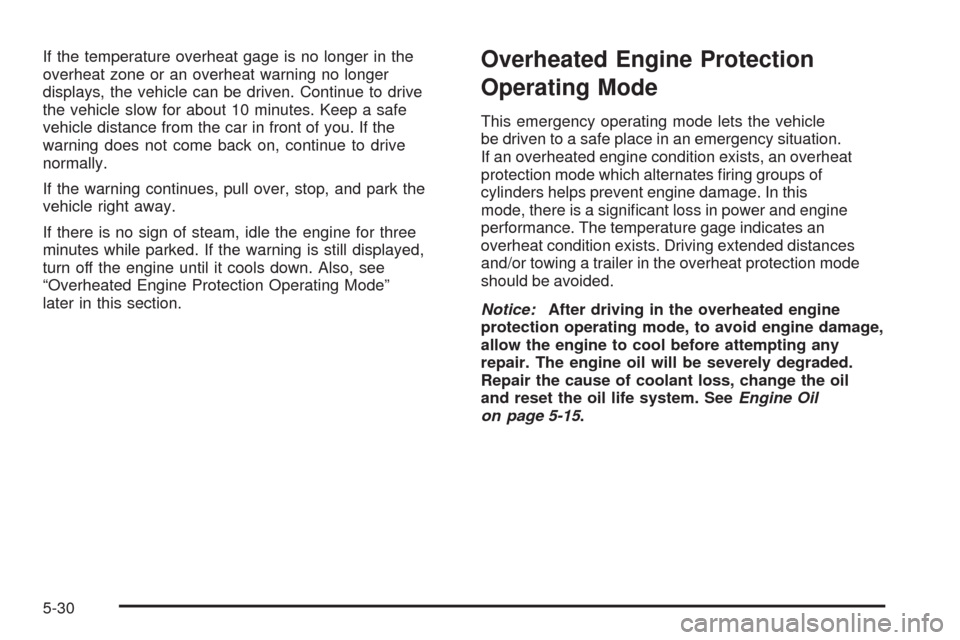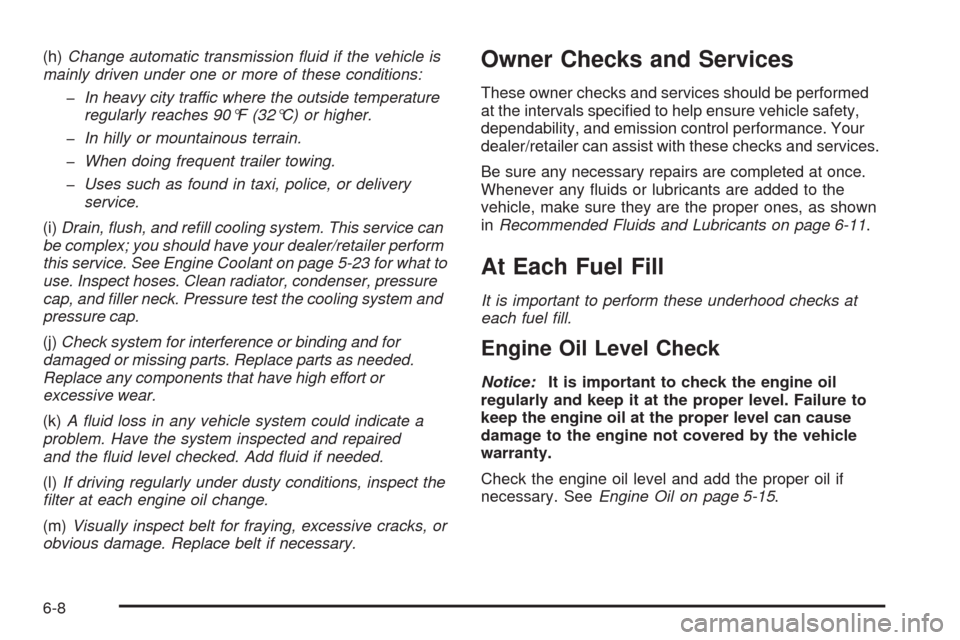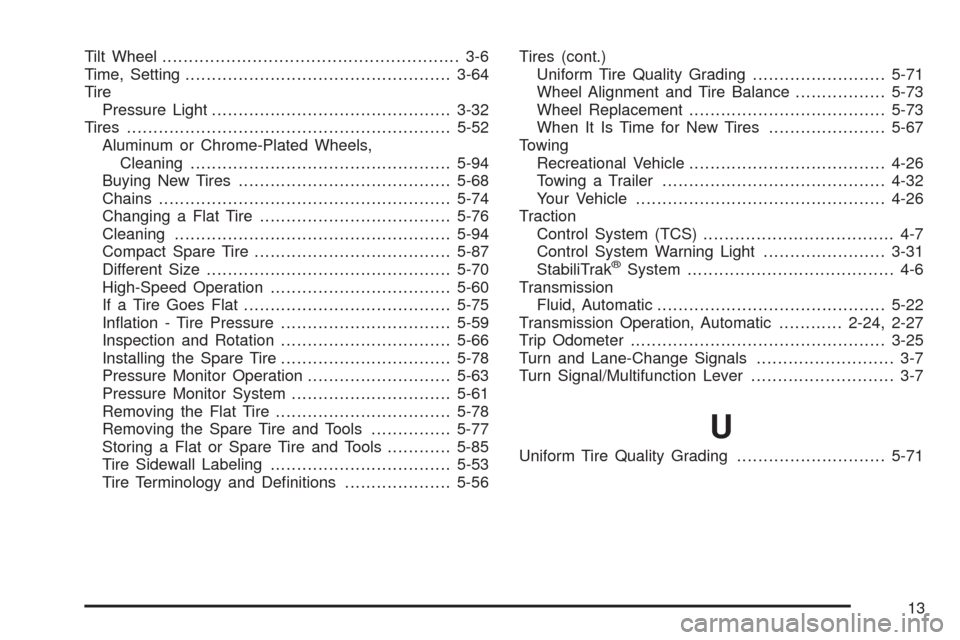Page 315 of 442

If Steam Is Coming From The Engine
Compartment
{CAUTION:
Steam from an overheated engine can burn you
badly, even if you just open the hood. Stay away
from the engine if you see or hear steam coming
from it. Turn it off and get everyone away from the
vehicle until it cools down. Wait until there is no sign
of steam or coolant before you open the hood.
If you keep driving when the vehicles engine is
overheated, the liquids in it can catch �re. You or
others could be badly burned. Stop the engine if
it overheats, and get out of the vehicle until the
engine is cool.
SeeOverheated Engine Protection Operating
Mode on page 5-30for information on driving
to a safe place in an emergency.
If No Steam Is Coming From The
Engine Compartment
If an engine overheat warning is displayed but no steam
can be seen or heard, the problem may not be too
serious. Sometimes the engine can get a little too
hot when the vehicle:
Climbs a long hill on a hot day.
Stops after high-speed driving.
Idles for long periods in traffic.
Tows a trailer.
If the overheat warning is displayed with no sign of
steam:
1. Turn the air conditioner off.
2. Turn the heater on to the highest temperature and
to the highest fan speed. Open the windows as
necessary.
3. If in a traffic jam, try to minimize engine load. Shift
to N (Neutral); otherwise, shift to the highest gear
while driving.
5-29
Page 316 of 442

If the temperature overheat gage is no longer in the
overheat zone or an overheat warning no longer
displays, the vehicle can be driven. Continue to drive
the vehicle slow for about 10 minutes. Keep a safe
vehicle distance from the car in front of you. If the
warning does not come back on, continue to drive
normally.
If the warning continues, pull over, stop, and park the
vehicle right away.
If there is no sign of steam, idle the engine for three
minutes while parked. If the warning is still displayed,
turn off the engine until it cools down. Also, see
“Overheated Engine Protection Operating Mode”
later in this section.Overheated Engine Protection
Operating Mode
This emergency operating mode lets the vehicle
be driven to a safe place in an emergency situation.
If an overheated engine condition exists, an overheat
protection mode which alternates �ring groups of
cylinders helps prevent engine damage. In this
mode, there is a signi�cant loss in power and engine
performance. The temperature gage indicates an
overheat condition exists. Driving extended distances
and/or towing a trailer in the overheat protection mode
should be avoided.
Notice:After driving in the overheated engine
protection operating mode, to avoid engine damage,
allow the engine to cool before attempting any
repair. The engine oil will be severely degraded.
Repair the cause of coolant loss, change the oil
and reset the oil life system. SeeEngine Oil
on page 5-15.
5-30
Page 388 of 442
Fuses Usage
18 Even Coils, Injectors
19 Odd Coils, Injectors
20 Emission Device 2
21 Spare
22Powertrain Control Module,
Ignition
23 Transmission
24 Mass Air�ow Sensor
25 Airbag Display
26 Spare
27 Stoplamp
28 Passenger Side Low-Beam
29 Driver Side High-Beam
30 Battery Main 3
32 Spare
33 Engine Control Module, Battery
34Transmission Control Module,
BatteryFuses Usage
35 Trailer Park Lamp
36 Front Wiper
37Driver Side Trailer Stoplamp,
Turn Signal
38 Spare
39 Fuel Pump
40 Not Used
41 All-Wheel Drive
42 Regulated Voltage Control
43Passenger Side Trailer Stoplamp,
Turn Signal
44 Spare
45 Front, Rear Washer
48 Rear Defogger
49 Antilock Brake System Motor
50 Battery Main 2
52 Daytime Running Lamps
53 Fog Lamps
5-102
Page 389 of 442
Fuses Usage
54 Climate Control System Blower
57 Battery Main 1
63 Electric Power Steering
When changing relays,
observe the location of the
notch on the old relay.
Install new relays with the
notch in the same location.
Relays Usage
31 Ignition Main
46 Air Conditioning Compressor Clutch
47 Powertrain
Relays Usage
51 Spare
55 Crank
56 Fan 1
58Passenger Side Trailer Stoplamp,
Turn Signal
59Driver Side Trailer Stoplamp,
Turn Signal
60 Fan 3
61 Fan 2
62 Fuel Pump
Misc. Usage
PLR Fuse Puller
5-103
Page 400 of 442

(h)Change automatic transmission fluid if the vehicle is
mainly driven under one or more of these conditions:
�In heavy city traffic where the outside temperature
regularly reaches 90°F (32°C) or higher.
�In hilly or mountainous terrain.
�When doing frequent trailer towing.
�Uses such as found in taxi, police, or delivery
service.
(i)Drain, flush, and refill cooling system. This service can
be complex; you should have your dealer/retailer perform
this service. See Engine Coolant on page 5-23 for what to
use. Inspect hoses. Clean radiator, condenser, pressure
cap, and filler neck. Pressure test the cooling system and
pressure cap.
(j)Check system for interference or binding and for
damaged or missing parts. Replace parts as needed.
Replace any components that have high effort or
excessive wear.
(k)A fluid loss in any vehicle system could indicate a
problem. Have the system inspected and repaired
and the fluid level checked. Add fluid if needed.
(l)If driving regularly under dusty conditions, inspect the
filter at each engine oil change.
(m)Visually inspect belt for fraying, excessive cracks, or
obvious damage. Replace belt if necessary.Owner Checks and Services
These owner checks and services should be performed
at the intervals speci�ed to help ensure vehicle safety,
dependability, and emission control performance. Your
dealer/retailer can assist with these checks and services.
Be sure any necessary repairs are completed at once.
Whenever any �uids or lubricants are added to the
vehicle, make sure they are the proper ones, as shown
inRecommended Fluids and Lubricants on page 6-11.
At Each Fuel Fill
It is important to perform these underhood checks at
each fuel fill.
Engine Oil Level Check
Notice:It is important to check the engine oil
regularly and keep it at the proper level. Failure to
keep the engine oil at the proper level can cause
damage to the engine not covered by the vehicle
warranty.
Check the engine oil level and add the proper oil if
necessary. SeeEngine Oil on page 5-15.
6-8
Page 441 of 442

Tilt Wheel........................................................ 3-6
Time, Setting..................................................3-64
Tire
Pressure Light.............................................3-32
Tires.............................................................5-52
Aluminum or Chrome-Plated Wheels,
Cleaning.................................................5-94
Buying New Tires........................................5-68
Chains.......................................................5-74
Changing a Flat Tire....................................5-76
Cleaning....................................................5-94
Compact Spare Tire.....................................5-87
Different Size..............................................5-70
High-Speed Operation..................................5-60
If a Tire Goes Flat.......................................5-75
In�ation - Tire Pressure................................5-59
Inspection and Rotation................................5-66
Installing the Spare Tire................................5-78
Pressure Monitor Operation...........................5-63
Pressure Monitor System..............................5-61
Removing the Flat Tire.................................5-78
Removing the Spare Tire and Tools...............5-77
Storing a Flat or Spare Tire and Tools............5-85
Tire Sidewall Labeling..................................5-53
Tire Terminology and De�nitions....................5-56Tires (cont.)
Uniform Tire Quality Grading.........................5-71
Wheel Alignment and Tire Balance.................5-73
Wheel Replacement.....................................5-73
When It Is Time for New Tires......................5-67
Towing
Recreational Vehicle.....................................4-26
Towing a Trailer..........................................4-32
Your Vehicle...............................................4-26
Traction
Control System (TCS).................................... 4-7
Control System Warning Light.......................3-31
StabiliTrak
®System....................................... 4-6
Transmission
Fluid, Automatic...........................................5-22
Transmission Operation, Automatic............2-24, 2-27
Trip Odometer................................................3-25
Turn and Lane-Change Signals.......................... 3-7
Turn Signal/Multifunction Lever........................... 3-7
U
Uniform Tire Quality Grading............................5-71
13